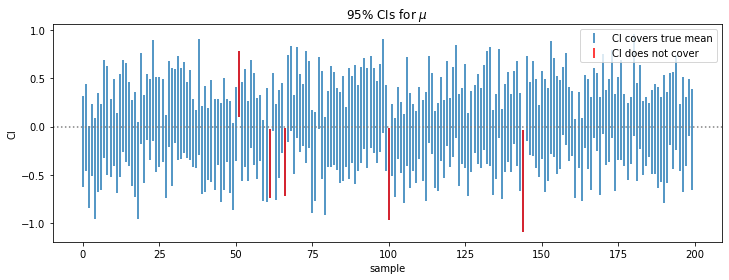Methods of Estimation
Method of moments estimation
Want to find a statistic \(T(X_1,...,X_n)\) s.t. \(E_\theta[T(X_1,...,X_n)] = h(\theta)\) where \(h\) has a well-defined inverse. Then, we can set \(T(X_1,...,X_n) = h(\hat\theta)\) s.t. \(\hat\theta = h^{-1}(T)\)
If \(X_1,..., X_n\) indep. and \(E_\theta(X_i) = h(\theta)\), then by substitution principle, we can estimate \(E_\theta(X_i)\) by \(\bar X\) and then \(\bar X = h(\hat\theta)\) and so \(\hat\theta = h^{-1}(\bar X)\)
Example: Exponential Distribution
\(X_1,...,X_n\) indep, \(f(x;\lambda) = \lambda \exp(-\lambda x), x\geq 0\), \(\lambda > 0\) is unknown.
Note that for \(r > 0, E_\lambda (X_i^r) = \lambda ^{-r}\Gamma(r+1)\) so that we have MoM estimator
Using \(r = 1\) gives the best estimation (minimized s.d.)
Example: Gamma Distribution
\(X_1,...,X_n\) indep. \(f(x;\lambda, \alpha) = \lambda^a x^{a-1}exp(-\lambda x) \Gamma(a)^{-1}, x\geq 0\). \(\lambda, a > 0\) are unknown. Note that \(E(X_i) = a/\lambda, var(X_i) = a/\lambda^2\), so that MoM gives
Confidence Interval
An interval \(\mathcal I = [l(X_1,...,X_n), u(X_1,...,X_n)]\) is a CI with coverage \(100p\%\) if
The pivotal method
Is not that often that we can measure such probability directly. One way to work around is to find a r.v. \(g(X_1,...,X_n,\theta)\) whose distribution is independent of \(\theta\) and any other unknown params.
Confidence Interval
An interval \(\mathcal I = [l(X_1,...,X_n), u(X_1,...,X_n)]\) is a CI with coverage \(100p\%\) if
Example
For \(X_1,...,X_{20}\) indep. \(\sim N(\mu, \sigma^2)\), the \(95\%\) CI is \([\bar X\pm -2.093\frac{S}{\sqrt{20}}]\).
The following example is 100 samples of size 20 from \(N(0, 1)\) and we note that \(95\%\) of the samples falls into the confidence interval.
samples = np.random.randn(200, 20)
mean = samples.mean(axis=1)
sd = samples.std(axis=1)
not_in_CI = np.concatenate((np.where(mean + 2.093 * sd / samples.shape[1]**0.5 < 0)[0],
np.where(mean - 2.093 * sd / samples.shape[1]**0.5 > 0)[0]))
plt.figure(figsize=(12, 4))
plt.errorbar(x=np.arange(samples.shape[0]), y=mean,
yerr = 2.093 * sd / 20**0.5 ,
fmt=" ", label="CI covers true mean")
plt.errorbar(x=not_in_CI, y=mean[not_in_CI],
yerr = 2.093 * sd[not_in_CI] / 20**0.5 ,
fmt=" ", color="red", label="CI does not cover")
plt.axhline(0, linestyle=":", color="grey")
plt.xlabel("sample"); plt.ylabel("CI")
plt.title(r"95% CIs for $\mu$"); plt.legend();

The pivotal method
Is not that often that we can measure such probability directly. One way to work around is to find a r.v. \(g(X_1,...,X_n,\theta)\) whose distribution is independent of \(\theta\) and any other unknown params.
Maximum Likelihood Estimation
Given \((X_1,...,X_n)\) r.v. with joint pdf
where \(\theta\)'s are unknown parameters.
The likelihood is defined as
note that \(x_1,...,x_n\) are fixed observations
Suppose that for each \(\vec x\), \((T_1(\vec x), ..., T_k(\vec x))\) maximize \(\mathcal L (\Theta)\) . Then maximum likelihood estimators (MLEs) of \(\Theta\) are
Existence and uniqueness
- MLE is essentially an ad hoc procedure albeit one that works very well in many problems.
- MLEs need not be unique, although in most cases, it is unique.
- MLEs may not exist, typically when the sample size is too small.
Sufficient Statistic
A statistic \(T = (T_1(\vec X), ..., T_m(\vec X))\) is sufficient for \(\theta\) if the conditional distribution of \(\vec X\) given \(T = t\) depends only on \(t\).
Neyman Factorization Theorem
\(T\) is sufficient for \(\theta\) IFF
Observed Fisher Information
Given the MLE \(\hat \theta\), the observed Fisher information is
Fisher information is an estimator for standard error, i.e.
Mathematically, this is the absolute curvature of the log-likelihood function at its maximum. If this is small, then the estimator is more well-defined (hence with smaller estimated s.e.)
Approximate normality of MLEs
Theorem For \(X_1,...,X_n\) indep. with pdf \(f\) for some real-valued \(\theta\in \Theta\), if
- \(\Theta\) is an open set
- \(A = \{x: f(x;\theta)> 0\}\) does not depend on \(\theta\) (true for the exponential families)
- \(l(x;\theta)\) is 3-time differentiable w.r.t. \(\theta\) for each \(x\in A\).
Then, with \(\theta_0\) being the true parameter, we have
proof. This conclusion follows Taylor expansion
where \(R_n = \frac{1}{2}(\hat\theta_n - \theta_0) \frac{\sum^nl''(X_i; \theta_n^*)}{n}\) is the Taylor's remainder with \(\theta_n^*\) in between \(\hat\theta_n, \theta_0\) so that
Then, note that \(\hat\theta_n - \theta_0 \rightarrow ^p 0\) (i.e. \(\hat\theta\)) is a "good" estimator from the assumption, and \(\frac{1}{n}\sum l''(X_i; \theta_n^*)\) is bounded. so that their product,
Therefore, \(\sqrt{\hat\theta_n - \theta_0}\rightarrow^d (0, \mathcal I(\theta_0)^{-1})\)